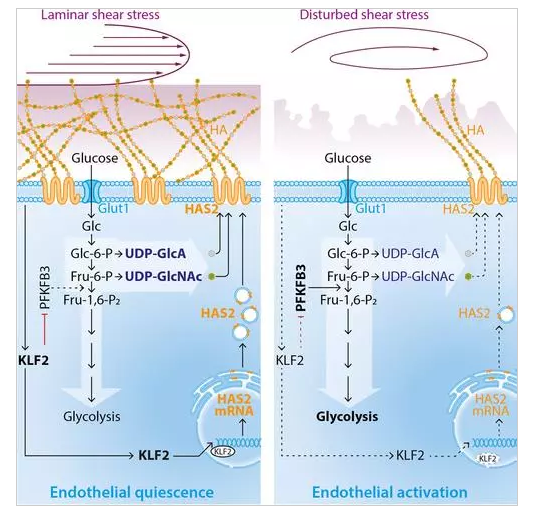内皮细胞糖萼的主要结构成分是透明质酸(HA)。HA是由UDP-葡萄糖胺(UDP-GlcNAc)和UDP-葡萄糖醛酸(UDP-GlcA)在质膜内表面合成的一种非常长的多糖。HA由合成酶HAS1(透明质酸合成酶1)、HAS2(透明质酸合成酶2)或HAS3(透明质酸合成酶3)合成,并分泌到细胞外空间。这3种亚型在酶的稳定性、HA的延伸率和HA底物的亲和力方面存在差异,5种亚型可能影响HA的合成。HAS2是哺乳动物中与HA分布相关的最广泛的亚型。6只HAS2基因敲除小鼠由于心血管发育的主要缺陷在妊娠早期死亡,推测HAS2以20单糖/s的速率聚合UDP-GlcA和UDP-GlcNAc,5使合成严重依赖于这些底物的胞浆可用性。UDP-GlcA and UDP-GlcNAc are derived from respectively the glucuronic acid and hexosamine biosynthesis pathways. We therefore postulated that endothelial HA, and hence glycocalyx thickness, would depend upon endothelial glucose metabolism. It has been shown that, in this respect, endothelial cells are characterized by a high glycolytic flux, where the possibility for glucobiosynthesis can be postulated to be regulated by this flux. Interestingly, the shear stress responsive transcription factor KLF2 has been shown to inhibit PFKFB3 (6-Phosphofructo-2-Kinase/Fructose-2,6-Biphosphatase 3),8 the key enzyme that drives (hyper)glycolysis.UDP-GlcA和UDP-GlcNAc分别来源于葡萄糖醛酸和己糖胺的生物合成途径。因此,我们假设内皮细胞的HA和糖萼的厚度将依赖于内皮细胞的葡萄糖代谢。已经证明,在这方面,内皮细胞具有高糖酵解通量的特征,其中糖生物合成的可能性可以假定由该通量调节。有趣的是,剪切应力反应转录因子KLF2已经被证明**了PFKFB3(6-磷酸果-2-激酶/果糖-2,6-二磷酸酶3),8-驱动(高)糖酵解的关键酶。





 库存查询
库存查询